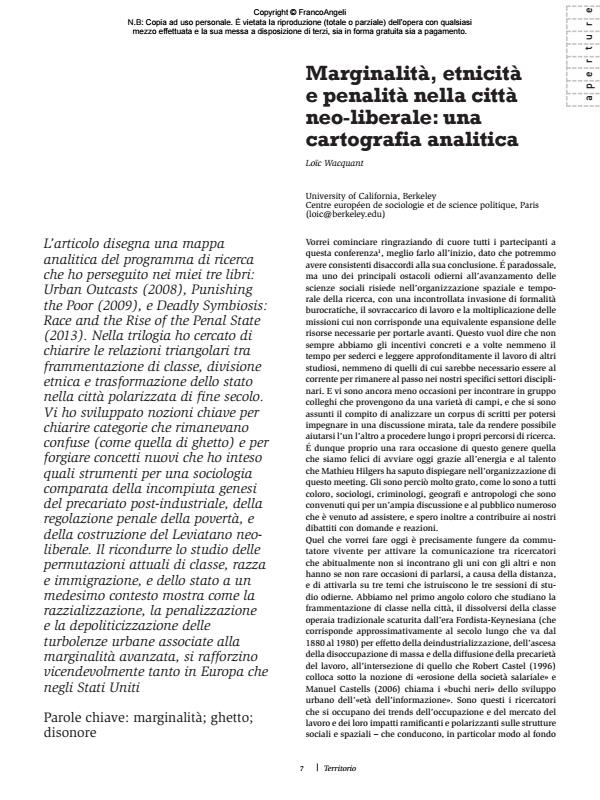Marginalità, etnicità e penalità nella città neo-liberale: una cartografia analitica
Titolo Rivista TERRITORIO
Autori/Curatori Loic Wacquant
Anno di pubblicazione 2014 Fascicolo 2014/70
Lingua Italiano Numero pagine 13 P. 7-19 Dimensione file 292 KB
DOI 10.3280/TR2017-070001
Il DOI è il codice a barre della proprietà intellettuale: per saperne di più
clicca qui
Qui sotto puoi vedere in anteprima la prima pagina di questo articolo.
Se questo articolo ti interessa, lo puoi acquistare (e scaricare in formato pdf) seguendo le facili indicazioni per acquistare il download credit. Acquista Download Credits per scaricare questo Articolo in formato PDF

FrancoAngeli è membro della Publishers International Linking Association, Inc (PILA)associazione indipendente e non profit per facilitare (attraverso i servizi tecnologici implementati da CrossRef.org) l’accesso degli studiosi ai contenuti digitali nelle pubblicazioni professionali e scientifiche
L’articolo disegna una mappa analitica del programma di ricerca che ho perseguito nei miei tre libri: Urban Outcasts (2008), Punishing the Poor (2009), e Deadly Symbiosis: Race and the Rise of the Penal State (2013). Nella trilogia ho cercato di chiarire le relazioni triangolari tra frammentazione di classe, divisione etnica e trasformazione dello stato nella città polarizzata di fine secolo. Vi ho sviluppato nozioni chiave per chiarire categorie che rimanevano confuse (come quella di ghetto) e per forgiare concetti nuovi che ho inteso quali strumenti per una sociologia comparata della incompiuta genesi del precariato post-industriale, della regolazione penale della povertà, e della costruzione del Leviatano neoliberale. Il ricondurre lo studio delle permutazioni attuali di classe, razza e immigrazione, e dello stato a un medesimo contesto mostra come la razzializzazione, la penalizzazione e la depoliticizzazione delle turbolenze urbane associate alla marginalità avanzata, si rafforzino vicendevolmente tanto in Europa che negli Stati Uniti
Parole chiave:Marginalità; ghetto; disonore
Loic Wacquant, Marginalità, etnicità e penalità nella città neo-liberale: una cartografia analitica in "TERRITORIO" 70/2014, pp 7-19, DOI: 10.3280/TR2017-070001